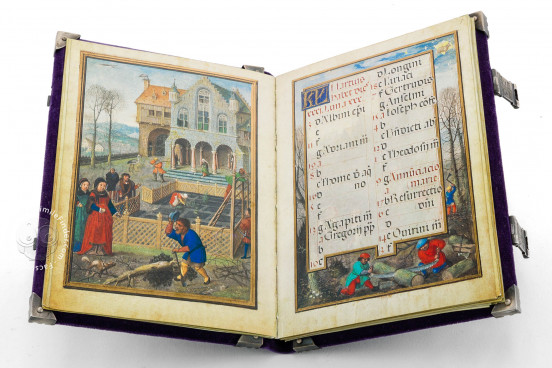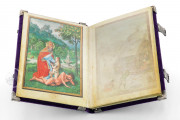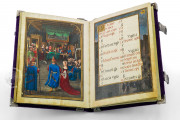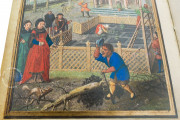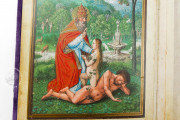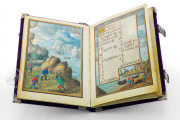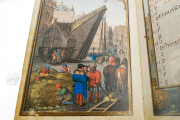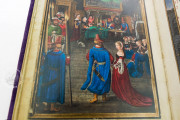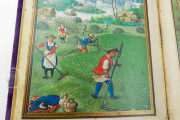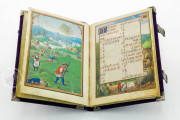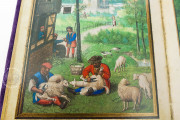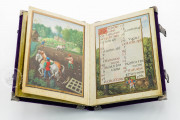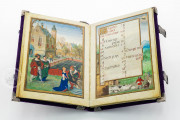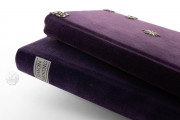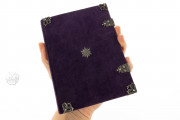The Flemish Calendar in Munich is a composite manuscript comprising fifteen leaves of the Munich-Montserrat Hours, including its Christian liturgical calendar and two full-page miniatures by Simon Bening, as well as fifteen leaves of a collection of Christian Latin prayers. The Munich-Montserrat Hours was created in Bruges around 1535-1540, and the prayers were written around 1600, presumably in Germany. The calendar is remarkable for presenting two landscapes that continue across the opening, occupying a full-page miniature on the left-hand page and a historiated border on the right-hand page.
We do not know when the two portions of the manuscript were assembled into the current volume. It was probably not when, but after the prayers were copied: that section of the book begins in medias res.
"The Most Pleasing Colorist"
Simon Bening (d. 1561) had an international reputation in his lifetime. Described by the Portuguese art critic Francisco da Hollanda (1517-1584) as "among the Flemish the most pleasing colorist," he was also hailed as early as 1530 as "the greatest master of illumination in all of Europe." His paintings preserved in the Munich manuscript well attest to his acumen.
Landscapes in Landscape Format
Each month of the calendar occupies two facing pages, with a full-page miniature on the left and the text surrounded by a historiated border (with identifiable human subjects) on the right. The ensembles for February and May include a body of water that extends across the pages, creating compositions in the "landscape format" of contemporary Flemish panel painting (fols. 3v-4r and 6v-7r).
Snowball Fight!
The activities depicted include many rural labors associated with particular times of year, such as wood chopping for January and harvesting hay for July (fols. 2v-3r and 8v-9r). City life is also depicted, as in the ensemble for October, where the scene is set at the wine market in the center of Bruges (fols. 11v-12r).
Some of the images include ancillary activities such as throwing snowballs in January, picking apples in August, and gathering acorns in September (fols. 3r, 10r, and 11r). Pastimes of the wealthy, such as courting and hunting, are also pictured (fols. 6v and 12v-13r).
Creation and Catastrophe
The two full-page miniatures originally illustrated the Hours of the Virgin, with the Creation of Eve beginning the cycle of eight scenes from Genesis, which also included the Flood (fols. 1v and 15r). In these miniatures, Bening displays his consummate skill in depicting lush landscapes and atmospheric weather.
A Guide to Christian Feasts
The calendar's text is written in two columns in Gothic Rotunda on the right-hand pages of the monthly ensembles, with the most important commemorations written in red. The first column is devoted to the first fourteen days of the month, and the second to the remaining days. The upper right of each historiated border shows an appropriate sign of the zodiac.
The collection of prayers is written in long lines (a single column) in a labored Humanistic Minuscule. Each prayer opens with a decorated initial in gold and delicate gold filigree on a colored ground.
Treasure of the Bavarian Court Library
By the second half of the seventeenth century, Ferdinand Maria (1636-1679), Elector of Bavaria, owned the book, which entered the Bavarian Hofbibliothek at his death. The holdings of the Hofbibliothek served as the foundation collection of the Hof- und Staatsbibliothek, which was renamed the Bayerische Staatsbibliothek in 1919. The current binding, of unknown date, is of purple velvet with silver furnishings.
We have 1 facsimile edition of the manuscript "Simon Bening's Flemish Calendar": Simon Benings Flämischer Kalender facsimile edition, published by Faksimile Verlag, 1987
Request Info / Price

